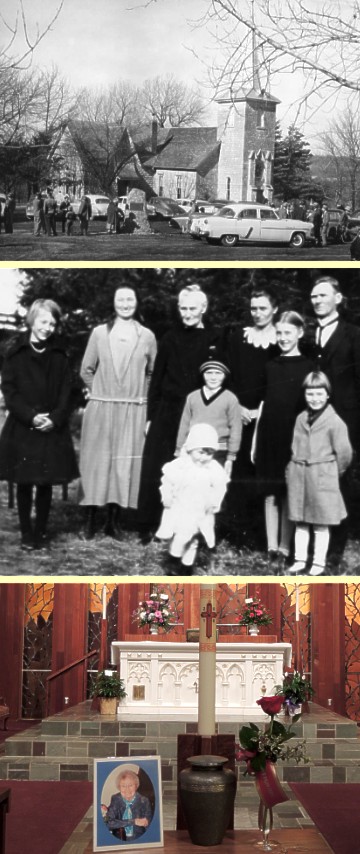Kansas Snapshots by Gloria Freeland - March 11, 2016
"An especially appropriate setting"
Last Saturday, we had Mom's memorial service at the First Lutheran Church here in Manhattan, Kansas. Some family
members couldn't attend, so I asked husband Art if he would videotape it for them.
Over the years, Art has videoed many events, often using multiple cameras so that he can later intermix the images to
give the viewer a variety of perspectives. He has frequently remarked that the need to constantly attend to focus and
composition means that he doesn't really get to see what happened until the pieces come together during the editing
process.
But after the service Saturday when he joined us at the reception in the church basement, he mentioned something he
kept thinking about during the songs and eulogy and all the rest - something that seemed both fitting, yet a bit ironic
as well.
Mom was a full-blooded Swede, so it is fitting this aspect of the story begins in Sweden.
In 1859, widow Maria Johnson and her many children emigrated and settled on the Blue River about 20 miles northwest of
Manhattan. Maria died about a year later, and the small town created by the settling of her children was named Mariadahl -
Maria's valley - in her honor.
One of the members of the Mariadahl church was her grandson Richard, born 18 years after her death. When he grew to
manhood, he chose to become a Lutheran minister and attended the Augustana seminary in Rock Island, Illinois. As part of
their ministerial training, candidates spent their summers serving Swedish communities. Richard went to Buxton, Iowa and
roomed in the home of Maria Carlberg, herself a Swedish immigrant. She had been forced to take in lodgers after the death
of her husband Johan in an accident at the Buxton coal mine.
Richard was attracted to Maria's daughter Johanna "Hannah" Lydia Carlberg.
Around 1908, because of what seemed to be an endless number of Swedish men in the seminary named Johnson, Richard
changed his name to John Johnson Richard, which he normally wrote as J. J. Richard.
After becoming a minister, he was posted to a rural church in Alabama. Hannah became his bride in 1910 and they went on
to live in many small rural places where J.J. served as the local Lutheran minister.
Several of Hannah's uncles also lived in Buxton and they convinced their sister Maria to leave the coal mining town
behind for the gold mining village of Victor, Colorado. While in Victor, Hannah's sister Hulda met and married Swedish
immigrant and miner Nels Mostrom. In 1920, their daughter Edith was born, followed by my mother Edla in 1924.
By this time, Hannah and husband J.J. were posted at the Marion Hill Lutheran Church in northern Morris County, Kansas.
A letter from the Richards to the Mostroms mentioned a farm that had become available just north of the church. The
Mostroms moved there in 1925.
When I wrote Mom's obituary, I explained how she became a schoolteacher and accepted her first position in Burns,
Kansas. And I also told how she and local farmer Edgar Freeland met and married and lived in Burns until 2000 when they
moved to Manhattan.
So this tale could be just one of how little things can have a big effect. If J.J.'s experiences in the Mariadahl church
had been unpleasant ones, perhaps he would never have considered becoming a minister. Being posted for the summer in
Buxton was a chance event that connected him with the Carlbergs. J.J.'s and Hannah's move to Morris County and the nearby
farm being vacated brought Mom's family to this part of Kansas. So while many of these and related events could not have
been foretold, they had a big effect. So it was fitting that J.J.'s granddaughter Sonja - my second cousin - was among
those attending the celebration of Mom's life.
But there is another part to this story and it was developing in the 1950s when my siblings and I were young. The
Tuttle Creek Dam on the Blue River was built in Manhattan as part of an attempt to control flooding on the Kansas, Missouri
and Mississippi rivers. During years of heavy rainfall, the water behind the dam would raise the Blue River until
Mariadahl would be submerged. So the village had to be abandoned.
The cemetery was moved to the western outskirts of Olsburg about four miles to the southeast. The steeple of the church
was moved to the cemetery entrance where it faces the road. The organ, originally donated by J.J's cousins, eventually
made its way to the First Methodist Church in Canton, Texas.
But the Mariadahl church bell went to another destination. It hangs in the tower over the church where Mom's service
was held Saturday. Some church members also believe the altar used by Rev. Jerry Reynolds during Mom's service originally
stood in the Mariadahl church.
Like several of the others previously mentioned, these events played out in a way that couldn't have been foreseen. But
instead of changing Mom's life, these seemed to have just created an especially appropriate setting for the service Saturday.
